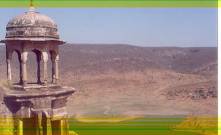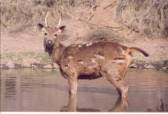Tigers enchanted me long before I read William Blake’s
“Tyger! Tyger! Burning bright in the forests of the night,”
No wonder it culminated in my visit to Sariska National Park by bike. The park is situated 200 kms from Delhi in Rajasthan. A relaxed drive from the bustling capital will
take you in five hours to this enchanting place.
This beautiful park encompasses 866 sqkm of tropical deciduous shrub forests. Aravalli range with its ravines and cliffs add to the scenic splendor of the park. A haven for
tigers, leopards, hyenas and deers; it also has a wide representation of avian population.
 Praying that no wild animal would take a fancy to me, I started the 20 km ride from the sanctuary gate. The fun of the ride was to tackle the hostile terrain of sand
mounds, rugged rocks, broken by off beat roads and loose gravel by bike. The end of the track offers the most breathtaking vista of the ruins of Kankwari fort, set amidst an arid scrub-land overlooking a lake fed by a natural spring. The fort built by Parikrama
kings was infamously used by Aurangazeb to imprison his brother Dhara Shikoh and later execute him. Part of the fort is in ruins today.
Praying that no wild animal would take a fancy to me, I started the 20 km ride from the sanctuary gate. The fun of the ride was to tackle the hostile terrain of sand
mounds, rugged rocks, broken by off beat roads and loose gravel by bike. The end of the track offers the most breathtaking vista of the ruins of Kankwari fort, set amidst an arid scrub-land overlooking a lake fed by a natural spring. The fort built by Parikrama
kings was infamously used by Aurangazeb to imprison his brother Dhara Shikoh and later execute him. Part of the fort is in ruins today.
It still has some exquisite paintings on the wall, which have withstood the test of time and scribble of modern Romeo’s to exemplify the skills of art practiced then.
The 5000-year-old Neelkanth temple and the ruined town of Bhangarh built during 1631 Ad by Madhoo Singh younger brother of Amar Singh, still stand to tell us the richness
of history Sariska has. Bhangarh town with a population of 10,000 people was built to a perfect town plan. The town is segregated distinctly as a market area with rows of shops on either side. A fort door separates this from an area of temples, of which one
Shiva temple has a distinct south Indian flavor of architecture and still well preserved with intricate stone carvings, notably of granite stones. The palace is built on the slopes of a hill camouflaged to the color of the sand overlooking the whole town.
This beautiful township’s destruction is still shrouded with mystery. The inhabitants abandoned this place to move to Ajabgarh. The easiest way to reach this town is through Sariska sanctuary; travel 22 kilometers to Thela village and then another 30 kilometers
to the town of Golakabas. You have to be ready for a bumpy ride but then Bhangarh would definitely compensate your effort.
The visit to the sanctuary is not all about seeing animals, but also above enjoying the beautiful home of the animals, experiencing the dynamism of the schema of the jungle,
understanding the thin balance of the food chain, which has been perpetually threatened by human activities.
 As I lie reminiscing in the hide built close to the water spot to watch animals closely without disturbing them, about the events that led me to this visit, I realized
had for company three spotted deer or chitals. Their short flirtation before my camera was good enough for me to shoot a good number of pictures. After a short break a hoard of sambhar deer and wild boars visited the water spot. At the end of my two-hour sojourn
in the hide, a jungle cat sped past who seemed to be too busy to pause for a snap.
As I lie reminiscing in the hide built close to the water spot to watch animals closely without disturbing them, about the events that led me to this visit, I realized
had for company three spotted deer or chitals. Their short flirtation before my camera was good enough for me to shoot a good number of pictures. After a short break a hoard of sambhar deer and wild boars visited the water spot. At the end of my two-hour sojourn
in the hide, a jungle cat sped past who seemed to be too busy to pause for a snap.
Life in the jungle doesn’t end with the sun going down. The dusk sees another world waking up. I shared a jeep for a night safari to the village of Taal. The village is in
the buffer forest area and has a temple with sulphur springs. This place is a favourite haunt for leopards. Our search leads us to the spotting of a cat family in the ascending order of their size. We first saw a common palm civet cat ferociously cleaning
his back, and then we a busy Indian small civet cat foraging for food. Our searchlight then caught the shimmering eyes of a leopard, which was lying down probably thinking what a dog’s day it was.
The cool breeze caressing me after a hot day rejuvenated my tired limbs. The drive back to the confines of my hotel in the open top jeep was filled with excitement. I saw
a hyena cross the road to join another at the side of the road to feast on the carcass of a wild animal. While I was busy chatting with my guide about the lucky day, I would have missed but for the keen site of my guide a glorious sight, which still lingers
in my eyes. As the jeep took a turn to my hotel right near the entrance below the metal road a full-grown leopard was feasting on his kill. We silently parked the jeep and waited holding our breath to enjoy this beautiful cat just ten feet away from us. Not
liking our intrusion he grunted ordering us to move away.
The next morning I beat the dawn by being inside the jungle along with my guide. Our trek took us along side a jungle stream: one of the rare natural sources of water for
the sanctuary. We walked up the stream passing the hanuman temple to spot the pugmarks of a tiger. The tiger trail led us to a rocky terrain upstream around two kilometers from the temple. The trail ended near a fresh tiger kill of a hapless sambhar. Evidence
suggested that the tiger would return later in the evening much before the hyenas could finish eating the carcass. The numerous pugmarks of hyenas suggested a pack in the vicinity.
This park has a rich population of fauna; if we can spend time not being obsessed with sighting a tiger, then we can equally enjoy the sightings of wild boar, jungle cats,
Indian small fox and a high population of ungulates.
I will do no justice if I don’t mention the rich avian population the sanctuary has to offer. They were a source of delight with their music and presence. A pair of brown
fish owls which are considered to be rare in this sanctuary was trying to nibble a little of the dead sambhar. The other birds I could spot and identify were gray-headed fish eagle, black winged stilt bird, red-welted leap wing, velvet and red ringed parakeet.
There are a lot more for the avid ornithologist who can spend time identifying them.
I want to finish this account and share my excitement with all, along with the message that as responsible enthusiasts of nature and wildlife let’s respect the home of the
animals and jungle dwellers. Let’s help in keeping their places clean by bringing back all non-degradable wastes like plastic and litter with us.
By
Baladev Manning